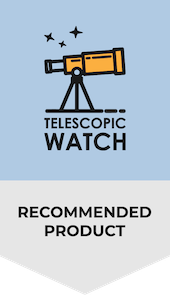Orion’s SkyQuest Series
Let me describe the Orion SkyQuest series of telescopes so you can see the XT8 Intelliscope in the context of the series. Regardless of which you select you will get a great package at a great price.
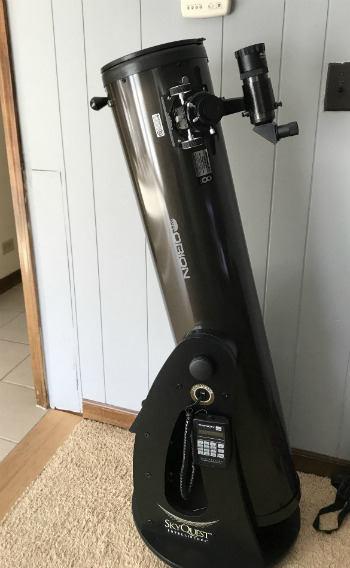
The XT8 Intelliscope, or XT8i, is part of Orion’s extensive SkyQuest line of floor standing Dobsonian telescopes. These are Newtonian reflector optical tube assemblies that range from the XT 4.5 at F7.9 to XX16G F4.7. The line includes solid tube Newtonian optical tubes and truss design Newtonian optical tubes.
In the Orion SkyQuest series, there are manual mounts which Orion refers to as the Classic Dobsonian series. These have no end letter designation. These include the XT4.5, XT6, XT8 and the XT10.
The Orion SkyQuest XT Intelliscope series is based on the same Dobsonian mount but Orion has added encoders in the package, all the needed wire, and a handset that reads the position of the optical tube. These are computer-assisted mounts that are also called PushTo or digital setting circle mounts. The Intelliscope hand controller will show you where to point the tube to find your target. However, the base does not incorporate motors, so you “PushTo” the target with computer guidance. As there are no motors. You do the tracking as you would with a manual Dobsonian scope.
The SkyQuest XT Intelliscope series includes the XT8i, XT10i, XT12i, XX12i and the XX14i. The XX indicates that those are truss tube designs as compared to the XT solid tube designs. With the Intelliscope series, you gain computer guidance to find your targets at a small incremental cost with very little increase in weight as compared to a GoTo mount. And you don’t need an external power supply to drive the mount.
The SkyQuest XT GoTo series is based on the same Dobsonian mounts. These carry a G designation. This series includes the XT8G, XT10G, XT12G, XX12G, XX14G, and XX16G. In the G series, they have added motors to the mount. You enter your target into the hand control, hit the GoTo button and the mount moves the optical tube to the target and then tracks it as it moves through the sky.
Whether manual, PushTo or GoTo, the solid optical tubes are the same within size as are the XX truss tube designs. It is the mount and the accessory packages that differ. So an XT8, XT8i, and XT8G have the same optical characteristics.
Here are the key specifications for the Orion SkyQuest XT8 Intelliscope that I am reviewing, as taken from the Orion website.
- Optical diameter = 203mm
- Focal length – 1200mm
- Focal ratio – f/5.9
- Primary Mirror – Parabolic
- Glass material – Low thermal expansion borosilicate glass
- 1.25″ Eyepieces – Sirius Plossl 25.0mm, 10.0mm
- Magnification – 48x, 120x
- Lowest useful magnification – 29x
- Highest useful magnification – 300x
- Highest theoretical magnification 406x
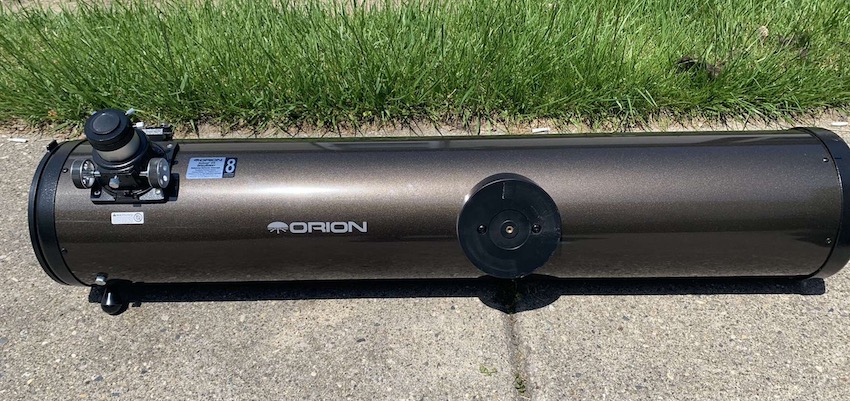
Assembly Of XT8i
The package arrives in two boxes. I am not going to go through the assembly, but if you can handle basic hand stargazing tools you will have no trouble putting the scope together. Most of the assembly is in the mount. The optical tube comes fully assembled.
Orion has created a very nice two video assembly guide for the XT Intelliscope series. Regardless of which one you have, the procedure is basically the same.
The stability of the mount
The stability of the mount is very important. The key values the Dobsonian style mount brings to amateur astronomy is an extremely stable and easy to use design. Unfortunately, many entry-level and even intermediate telescope packages come with mounts that wobble and shake when you touch them to focus. A light breeze and the image is shaking all over the place.
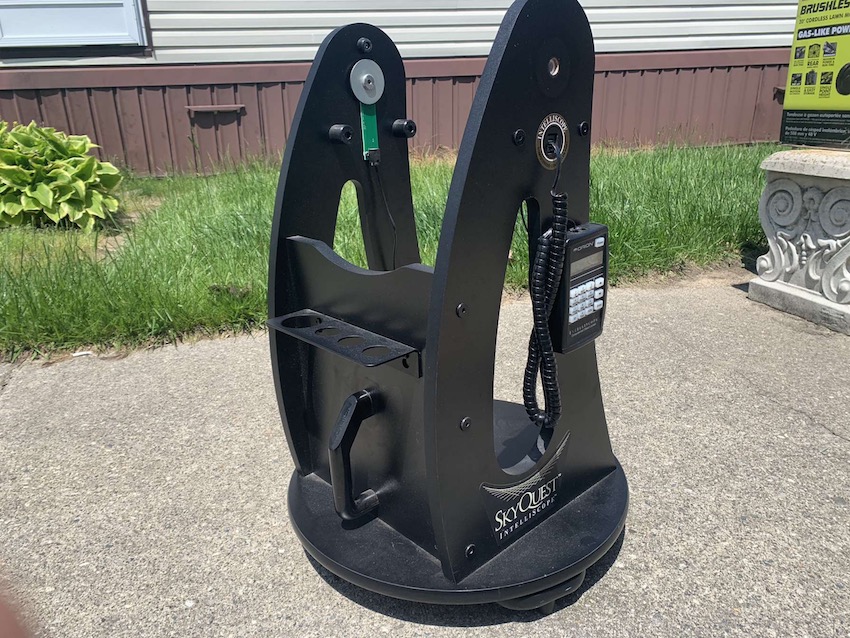
My friend has an 8” GoTo scope of a different brand. His is tripod based. It is a very nice package but every time we focus, the image shakes like crazy for a couple of seconds. And if we are in a breeze, you can see that in the eyepiece. Once it settles down, it is a great scope, but I have none of this in the XT8i. This is especially important when you are viewing at higher magnifications.
Size and Weight
Many first-time telescope buyers see the size of the XT8 Intelliscope and are impressed by the size. Some are also concerned by the size. Here is how I handle that.
I can easily lift the entire 42-pound package and carry it, but that would be awkward for me on stairs, and I would not want to carry it a long distance.
Fortunately, as you see in the assembly video, the optical tube easily lifts off the base with the removal of the two caps on the end so you can carry the 20-pound tube alone. If 20 pounds is comfortable for you, this makes it easier to take it up and down stairs if you store it in the house. Some people add strap handles to make this even easier.
Then you move the 21-pound base separately. If you put your eyepieces and other accessories in a shoulder bag or backpack you could move the whole thing in two trips.
However, I do not keep my XT8i in the house. I store mine in my unheated, well-ventilated garage. Not only does this eliminate stairs but the scope is always near the ambient temperature. A dry, well-ventilated shed would do just as well.
With any mirror-based telescope, including SCTs and MCTs, the scope works best when the mirror has reached the same temperature as the surroundings. This is often referred to as the “cool down” period. By storing mine outside, I eliminate this cool down period.
As you can see in the photo, mine sits on a cart, fully assembled, ready to be rolled down the driveway to my observing area on my front sidewalk. Some people use a padded hand truck for the same purpose. It just makes it so easy to move.
This would work well for larger scopes in the Orion SkyQuest line as well. I have my eye on the XX12i as my next upgrade, and it will go in the garage on this cart, or perhaps be moved with a hand truck.
I place my observing chair on the cart with the scope, grab a bucket that has my eyepieces and other accessories and off I go. When I get to my observing spot on the sidewalk, I lift the scope off the cart and place it on the ground. If I were moving the scope across dirt, grass or uneven ground, I would likely use a hand truck rather than this flat cart.
Once at my observing site I set up my chair, insert my eyepiece and I am ready to go in a matter of minutes. This makes the XT8i as quick to move and set-up as my much smaller and lighter 80 mm telescopes.
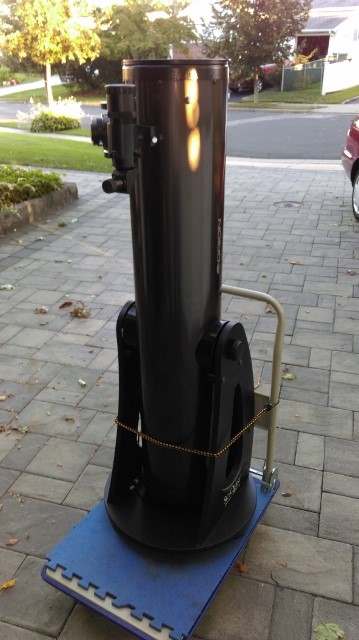
But even if you have to store your XT8i in the house, as long as 21 pounds is a comfortable weight for you, you will find the XT8i quick and easy to move and set-up. Just plan your trips and you will be viewing in no time.
Is It Good For Car Travel?
I live in a very lightly polluted area, so taking my XT8i to darker, remote observing sites is important to me. The XT8i goes right in the back of my SUV, fully assembled, with one side of the back seat down. That leaves room for additional equipment like my observing chair, eyepieces and other equipment. I can even fit two of my friends for a fun evening of observing at a darker location.
If you drive a standard car, the optical tube is about 48 inches and will fit nicely across the back seat of most cars. You then put the mount in the passenger seat or in the trunk along with your other accessories. Note that the Orion XT 10 Intelliscope tube is the same length so if you want to go up a size, that fits well in most cars too.
Reviewing Intelliscope Features
The Intelliscope object locator handset plugs into a port on the side of the mount. Unlike many GoTo mounts, there is no need for an external power supply. The handset uses a simple 9V battery. The battery lasts a long time, but I keep a spare in my accessory kit, just in case I need it.
The buttons are large so they can be manipulated with gloves. They have a nice soft covering on them so they are comfortable to use. The keys are backlit so you can see them at night, but the handset is not so bright as to be a problem for your dark-adapted eyes. You can adjust the backlighting level to suit your location.
In order for the Intelliscope to help you find your targets it first needs to know where it is on the planet. To accomplish this you do a simple two-star alignment. This only takes a couple of minutes once you have done it a few times.
To do the alignment, you put the optical tube vertical. There is a stop in the mount that you adjust during assembly which sets this vertical position. It is not required for the base to be absolutely level, just get it close. I use mine on the front sidewalk, which is not level.
You then turn on the handset. You will use two bright stars as your alignment stars. So, of the entire sky, you only need to know two stars. As the months go by and the sky moves, you can change the stars you use for alignment, but during any one season, two is all you need to know. And, over time, you will learn a lot more than two stars in the sky.
If you can see Polaris, the North Star, then you only need one other star for alignment. The manual offers suggestions and the hand controller provides a list of bright alignment stars, so this is really pretty easy.
You set the tube vertically to the mount, turn on the handset and then move the tube so that the first star is centred in the eyepiece, and hit enter. It asks for your second star. You put the second alignment star in the centre of the eyepiece and hit enter.
At this point, the mount is aligned and knows where all the stars, planets and deep sky objects are in the sky. You put in the one you want to see, out of the thousands included in the database, and the handset will guide you to the target.
The Tour Feature – The XT8i also has a cool tour feature that will take you on a tour of the best objects in the sky tonight. If you don’t know what you want to look at, just take the tour.
There are over 14,000 objects catalogued in the Intelliscope hand controller. In your lifetime, you will only get to see a fraction of them. The Intelliscope will be showing you the sights for years.
Orion offers a nice overview video of how the Intelliscope works. And, yes, it really is this easy.
As you can see in the picture of the handset, it uses two numerical guides. As you move the tube in the direction indicated by the arrow, the numbers will approach 0,0. When you hit 0,0, the target should be within the field of view of your low power eyepiece. I have found it to be very accurate.
Included Accessories
The package includes two Plossl eyepieces, a 10 mm and a 25 mm. These are very good quality eyepieces and produce excellent views. I have used other Orion Plossl eyepieces, and they are all good. Over time you will wish to expand your eyepiece collection, but these first two give you an excellent start.
If you add an optional 2X Barlow you will have 4 magnifications which is plenty. Any Barlow will work, but Orion has a very nice 2X shorty Barlow that will work wonderfully with the XT8i. I would recommend you add it with your initial purchase.
The 25 mm will give you 48X and works well as your low power eyepiece. It provides a field of view of approximately 1 degree which is about the width of two moons set side by side. This works well for open clusters, the Moon, and nebulae that work best at low power. Place that 25 mm in the 2X Barlow and you have 96X.
The 10 mm eyepiece will give you 120X which will work well for the Moon, planets, globular clusters, splitting medium double stars and nebulae that may require higher power. Place that in the 2X Barlow lens and you have 240X.
There is an included eyepiece rack. This has 3 holes for 1.25” eyepieces and one for a 2” eyepiece. This comes in very handy. At the start of my observing session, I will typically put out the eyepieces I plan to use that evening so I can move from one to another easily and quickly.
The 2” Crayford type focuser gives you the flexibility of using 2” and 1.25” eyepieces which is very valuable for a scope of this aperture. The focuser is smooth and easy to use even when I put in large heavy 2” eyepieces.
The focuser comes with a 2” to 1.25” adapter. Over time many people will add one or two 2” eyepieces for low power wide views, but the rest of the eyepiece set will usually be 1.25”.
The package includes a very nice 9X50 right angle correct image, RACI, finder scope which I like very much. The right angle works very well with the position of the focuser so I can be seated, viewing and move easily from the eyepiece to the finder and back. This works like half of a binocular so as you move the scope stars in the field of view move in the correct direction.
Because I live in a very light polluted area, there are not a lot of stars that are naked eye visible in my sky. As a result, I find most red dot finders, which are much less expensive, to be less than useful for star hoping to find my targets. But this RACI finder works very well for this purpose.
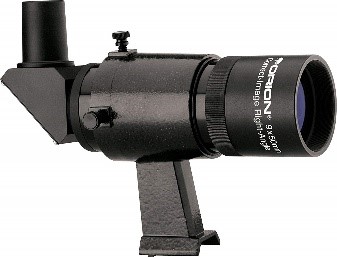
You may wonder why I mention star hopping when I have a computer-assisted scope. The XT8 Intelliscope offers a key advantage over many GoTo scopes. It allows you to use the mount with or without using the Intelliscope feature. It is like GPS in your car.
If you want to try your hand at star hopping as part of your learning process, the RACI finder will be very helpful, especially if you have a light of light pollution in your observing location. So you have both a computer-assisted and a manual scope according to your wishes that night.
Like the GPS in my car, I don’t use the Intelliscope every night. If I want to view the Moon or planets, I can find them naked eye. I don’t need help to find them. However, if I want to work a list of star clusters or double stars I can fire up the Intelliscope and have a very productive evening of stargazing without the work of trying to find them in my very light polluted sky.
Collimation Of XT8 Intelliscope
Collimation is part of the routine maintenance you will do with your telescope. It is quick and easy, so there is nothing to be concerned about. And Orion includes the tools to do it. Many other telescope makers do not include these essential tools.
Orion provides a collimation cap and the hex wrench needed for the job. This is a great tool for checking the alignment or collimation of the scope. Like checking the air in your tires, you should periodically check to see that the mirrors are properly aligned. Some people say you should do this every time you use a Newtonian scope but I have found the XT8i holds collimation extremely well. I typically check it about every 10 uses.
There are other, more expensive tools on the market that you may wish to explore over time, but the included collimation cap gets the job done. Orion provides a very nice instructional video showing you how to collimate your scope.
Note that the XT8i comes collimated from the factory so you should be in good shape when it arrives. That is a good time to learn how to do your collimation because it should be very close right out of the box. The bumps and bounces of shipping may have shifted things a hair, but it should be close so don’t feel you are going to have to make major adjustments. If it looks good, it probably is good. Likely you will have to make no adjustments at all.
Enjoying the Night Sky with the Orion SkyQuest XT8 Intelliscope?
The more aperture you have, the more you can see, and the 8”/203 mm aperture of the XT8i really pulls in the light.
Planets look great. I have viewed Mercury, Venus, Mars, Jupiter, and Saturn on many occasions. During this past summer, there was a time when Venus, Mars, Jupiter, and Saturn were all in the night sky at the same time. That was wonderful.
Mercury is so small that it looks like a star. You can only view it just after sunset or just before sunrise, depending on its position in its orbit around the Sun. Be very cautious because you don’t want to accidentally catch the sun in the scope without a solar filter as it could damage your eye.
Venus is covered in clouds so you can’t see much in detail but you can see phases. Venus goes through phases similar to the moon.
I have seen Jupiter’s cloud bands and Jupiter’s great red spot. The four Galilean moons look like stars. They move so quickly that you can actually see them change position over a 2-3 hour observing session. And they will be in different positions every night. You can easily see the cloud bands and, on a clear calm night, you can see surprising detail.
Saturn is the rock star of the planets. And there is little that is more spectacular than the rings of Saturn. I never get tired of Saturn. On a clear night, you can cloud bands on Saturn too. The XT8i has enough aperture to let you see some of the moons as well, even though they are approximately 750 million miles away.
Imagine looking at Uranus and Neptune which are 1.7 and 2.7 billion miles away. The light you see in the eyepiece when looking at Neptune had to travel over 5 billion miles to reach you.
Even from my light polluted home location, there are so many beautiful open star clusters. Some of my favourites are the Pleiades, the Hyades, and the Double Cluster. Many telescopes have trouble fitting these large clusters into the field of view. However, the 2” focuser of the XT8i allows me to use wide view eyepieces. My 38 mm 2” eyepiece presents a field of view of 2.2 degrees which is large enough to present these clusters in whole. This would be difficult with other types of 8” scopes that have long focal lengths and only use 1.25” eyepieces.
Among deep space objects, DSOs I think my favourites are the globular clusters. These are clusters of stars that are so tightly packed that they look like a bright ball. But as you crank up the magnification the XT8i will let you resolve the shape of the cluster and individual stars. One of my favourites is Messier 92 which is a globular cluster in the constellation of Hercules. To me, it looks like a rose petal impression as the individual stars that I could resolve seemed to create waving streaks across the cluster at 180X. Imagine a white rose, fully opened. Now imagine spots of dew lining the edges of the petals, lit from behind so they seem to glow. That is what it looked like to me in the eyepiece of my XT8i.
Some of the large nebulae also require a very wide field of view. So, be sure to plan to take advantage of the XT8i’s 2” focuser. Add a least one and preferably two 2” wide view eyepieces to your set. I have a 38 mm and a 20 mm 2” wide view and I use them a lot.
If you compare this to the typical F10 SCT that comes with a 1.25” diagonal, they are limited to about 1-degree FOV. To try to see wider targets with these scopes you would have to add expensive extra optics or visual backs to accept 2” eyepieces. But the XT8i does this standard.
The Orion Nebula and the Ring Nebula look great in the XT8i even from my light polluted suburban location. The Intelliscope has no problem finding them.
The XT8i is great a splitting double stars which appear to be a single star but are actually two stars that are very close together. If you use a zoom eyepiece, as I do, you can actually watch them split. Some good examples are Albireo, Mizar, and Alcor which are easy low power doubles. Even with the 25 mm and 10 mm eyepieces that come with the XT8i, you can split a lot of doubles. If you add the 2X Barlow I mentioned earlier you can split the Double Double in Lyra, near the bright star Vega, which requires over 200X to get a clean split.
The Orion Nebula is one of the real showcase nebulae. When I am at a public outreach event at the Custer Observatory, operating the 14” telescope, I often target the Orion Nebula for the public. The Trapezium is a four star group in the centre of the nebula. They are designated A to D. These can be seen even in my 80 mm refractors. But the XT8i allows me to see the elusive E and F stars too.
And don’t overlook the Moon. I have observed the Moon at over 400X with the XT8i on a really clear night. I like to visit the Apollo landing sites. I study large craters and mountains on the moon, some of which extend out into space along the edge. There is still so much to enjoy on the Moon and the XT8i has done a great job of showing me the sights.
Taking Advantage of a Computer Assisted System
A lot of telescopes end up in the closet because people lose interest. They can’t find much beyond the Moon and the bright planets. But with the XT8 Intelliscope, you have the equivalent of a GPS on your scope. Just punch in what you want to see and the scope guides you to the target. This can be especially valuable in a very light polluted area where there are few stars in the sky.
The system is so easy to use. If you use a GPS in your car, home computer apps or phone apps, you will find setting up the XT8i very simple. Members of my club were quite impressed as to how easy it was to use.
If I wanted to find the globular M92 that I mentioned earlier, using the handset, I would select the Messier catalogue and enter 92. The XT8i would then show me which direction to turn the scope. Once at the proper compass position I would then follow the arrow on the handset to raise or lower the tube to get the target centred in the eyepiece. And there would be Messier 92, this beautiful globular cluster in my eyepiece. Now I would just change from a low power to a high power eyepiece to bring out the wonder of the cluster.
And there are thousands of wonderful targets in the Messier and New General Catalogue that can be seen with the XT8i. The Messier Catalogue alone includes over 100 clusters, galaxies, nebulae, and other objects, all of which can be seen with the XT8i.
Possible Tool Set Upgrades
Overtime you will want to add to your tool set. Here are a few ideas.
Eyepieces – The number one upgrade you will want will be to expand your magnification options through added eyepieces or Barlow lenses. The included eyepieces provide 48X and 120X but the scope can handle much more.
Since the XT8i has a 2” focuser to you can use 1.25” and 2” industry standard eyepieces and other visual accessories. I keep adding new ones to bring out the detail in the things that I view. I have a set of colored filters specifically for planets. These can highlight the bands of Saturn and Jupiter and help you see the shadings of the surface of Mars.
My standard eyepiece set now includes two 2” eyepieces for low power wide views. I have added 4 more 1.25” eyepieces. I have a 2X and a 2.5X Barlow. This gives me a magnification range from 31X to 220X without the Barlow lenses. With the use of a Barlow, I can test the image all the way to 545X.
Most of the time atmosphere limits me to about 240X or less. But on those special nights, when the atmosphere is exceptionally clear and calm I have the tools to test higher magnifications. Jupiter looks amazing at 300X and I have viewed the moon at over 400X with the XT8i.
My favourite eyepiece in my XT8i an 8-24 mm zoom eyepiece that works like the zoom lens on a camera. In fact, I have two zoom eyepieces, one from Celestron and one from Baader Hyperion. I like them both but the Baader Hyperion 8-24 Clickstop zoom is clearly superior.
If there were one thing I would change about the XT8i package, and this would be a minor point, is that it would be nice to have a two-speed focuser. I have used these in other scopes. But, to be honest, I don’t feel at all limited by the standard focuser. It does a great job even with my big heavy eyepieces.
Summary
To summarise my review of XT8 Intelliscope, I consider it a very good value telescope. I have enjoyed it for over three years and expect it will be my main scope for many years to come. The simplicity of use would also make it suitable for a teen. You don’t have to know a lot about the sky to get started and the scope will let you use it manually when you like. Just take into consideration the size and weight. But if you can keep it at ground level and move it with a cart of a hand truck, the size and weight become much less of an issue.
You can take snapshots and short videos through the eyepiece, but this is not a package that would be optimal for someone who wanted to get into imaging. The Orion SkyQuest XTG or XXG GoTo series would be more suitable for video imaging. Once captured you run the captured video through a computer program to stack the frames. You can do some of that with the XT8i, but the G would be a better choice.
As I have learned, over time people tend to have more than one scope. I have four. This is my “light bucket”, my large scope. This is the one I use 75% of the time. But I don’t take it on vacation as it takes too much room in the car. For that, I use my smaller scopes.
If you are looking for a first scope or looking for an upgrade from a smaller scope this is an excellent choice. This can find things for you in the sky for you.
A Few Additional Tips
Many people like to use a Moon filter because it is so bright. I often use one. There are many types which are rated by the percentage of light they transmit. With the XT8i I prefer a 25% filter. Many will recommend a 13% filter for an 8” scope but I prefer the 25%.
The best time to view the moon is when it is NOT full. As the Moon goes from new, total dark, to the first quarter, the dark line moves across the surface night after night. That is where you get deep shadows and lots of contrast. And don’t forget to look along the edge to see the mountains that extend out into space.
Remember that the Moon is also a source of light pollution. The light from the Moon reduces the contrast between the sky and deep sky objects. They will look better when the Moon is not in the sky.
If you are observing from a very light polluted area, focus your observing time there on bright targets such as the Moon, planets, open star clusters, and double stars as well as some bright nebula and globular clusters. Save the nebula, galaxies and some of the dimmer globular clusters for when you can visit a darker site. This has nothing to do with limitations of the XT8i. It is due to the lack of contrast between the target and the sky. This is why you don’t see stars during the day, the Sun washes them out.
The XT8i will help you find anything but the contrast with the light polluted sky can make galaxies, most nebula and dimmer globular clusters seem very washed out or even impossible to see. This has nothing to do with the scope. Save those for occasions when you can get to a darker area.
My best viewing direction is northeast to southeast. This is the darkest part of my sky so I focus my observing there. Try to spend the majority of your observing time in the darkest part of your sky. Remember that the new targets will appear from the East and move across the sky to the West, so wait for them to come into your best viewing area.
At the end of this XT8i review, all I can say is that I hope you enjoy your Orion XT8i as much as I enjoy mine.

